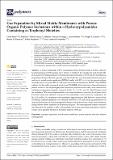Por favor, use este identificador para citar o enlazar a este item:
http://hdl.handle.net/10261/252357COMPARTIR / EXPORTAR:
 SHARE SHARE
 CORE
BASE CORE
BASE
|
|
| Visualizar otros formatos: MARC | Dublin Core | RDF | ORE | MODS | METS | DIDL | DATACITE | |

| Título: | Gas separation by mixed matrix membranes with porous organic polymer inclusions within o-hydroxypolyamides containing m-terphenyl moieties |
Autor: | Soto, Cenit; Torres-Cuevas, Edwin S.; González-Ortega, Alfonso; Palacio, Laura; Lozano López, Ángel Emilio CSIC ORCID ; Freeman, Benny D.; Prádanos, Pedro; Hernández, Antonio | Palabras clave: | Hydrogen separation Mixed matrix membranes Porous polymer networks Thermal rearrangement |
Fecha de publicación: | 2021 | Editor: | Multidisciplinary Digital Publishing Institute | Citación: | Polymers 13 (2021) | Resumen: | A hydroxypolyamide (HPA) manufactured from 2,2-bis(3-amino-4-hydroxy phenyl)-hexafluoropropane (APAF) diamine and 5-terbutyl-m-terphenyl-4,4-dicarboxylic acid chloride (tBT-pCl), and a copolyimide produced by stochiometric copolymerization of APAF and 4,4-(hexafluoroiso-propylidene) diamine (6FpDA), using the same diacid chloride, were obtained and used as polymeric matrixes in mixed matrix membranes (MMMs) loaded with 20% (w/w) of two porous polymer networks (triptycene-isatin, PPN-1, and triptycene-trifluoroacetophenone, PPN-2). These MMMs, and also the thermally rearranged membranes (TR-MMMs) that underwent a thermal treatment process to convert the o-hydroxypolyamide moieties to polybenzoxazole ones, were characterized, and their gas separation properties evaluated for H, N, O, CH, and CO. Both TR process and the addition of PPN increased permeability with minor decreases in selectivity for all gases tested. Excellent results were obtained, in terms of the permeability versus selectivity compromise, for H/CH and H/N separations with membranes approaching the 2008 Robeson’s trade-off line. The best gas separation properties were obtained when PPN-2 was used. Finally, gas permeation was characterized in terms of chain intersegmental distance and fraction of free volume of the membrane along with the kinetic diameters of the permeated gases. The intersegmental distance increased after TR and/or the addition of PPN-2. Permeability followed an exponential dependence with free volume and a quadratic function of the kinetic diameter of the gas. | Versión del editor: | http://dx.doi.org/10.3390/polym13060931 | URI: | http://hdl.handle.net/10261/252357 | DOI: | 10.3390/polym13060931 | Identificadores: | doi: 10.3390/polym13060931 issn: 2073-4360 |
| Aparece en las colecciones: | (ICTP) Artículos |
Ficheros en este ítem:
| Fichero | Descripción | Tamaño | Formato | |
|---|---|---|---|---|
| polymers-13-00931.pdf | 3,17 MB | Adobe PDF |  Visualizar/Abrir |
CORE Recommender
PubMed Central
Citations
6
checked on 10-abr-2024
SCOPUSTM
Citations
11
checked on 12-abr-2024
WEB OF SCIENCETM
Citations
10
checked on 28-feb-2024
Page view(s)
66
checked on 19-abr-2024
Download(s)
60
checked on 19-abr-2024
Google ScholarTM
Check
Altmetric
Altmetric
Artículos relacionados:
NOTA: Los ítems de Digital.CSIC están protegidos por copyright, con todos los derechos reservados, a menos que se indique lo contrario.
